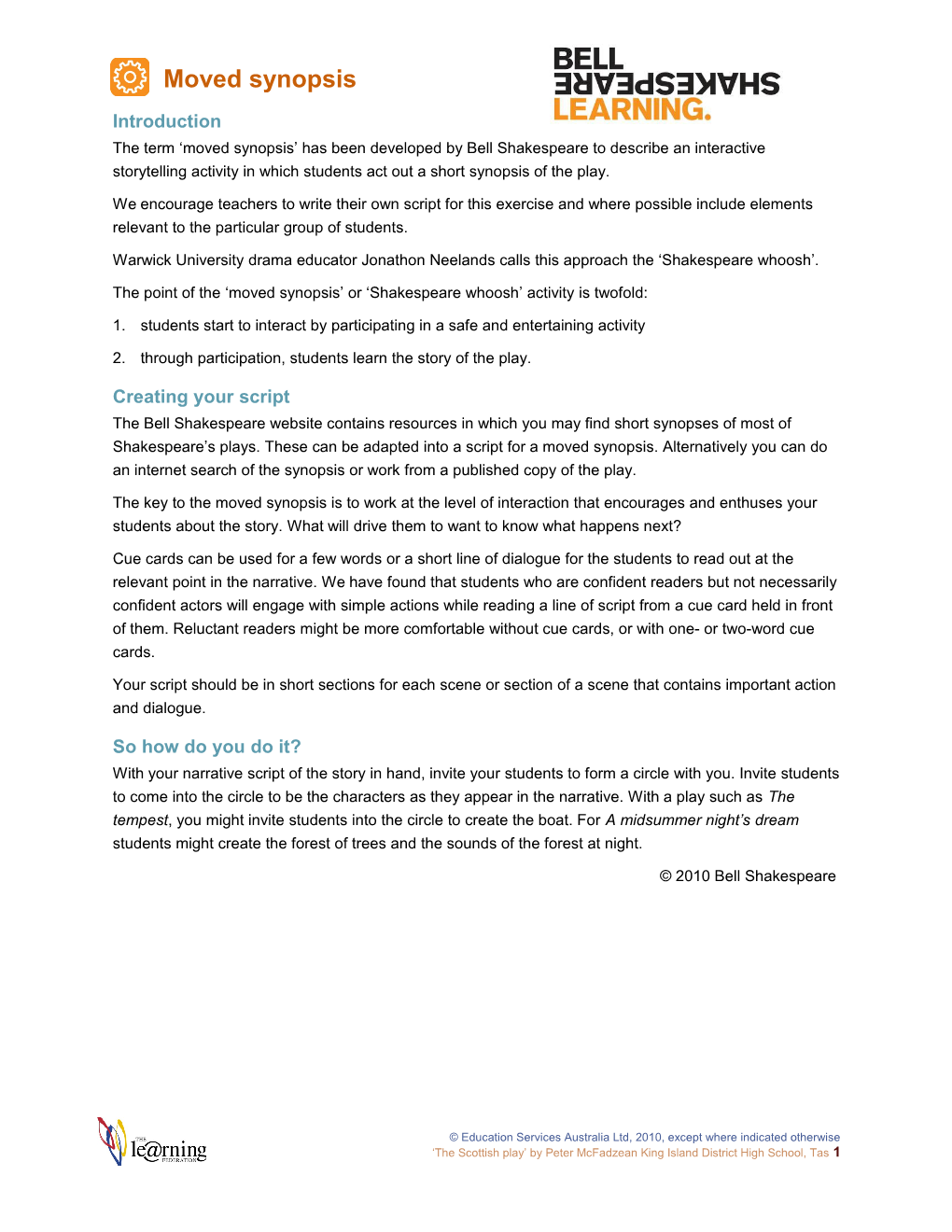Moved synopsis
Introduction
The term ‘moved synopsis’ has been developed by Bell Shakespeare to describe an interactive storytelling activity in which students act out a short synopsis of the play.
We encourage teachers to write their own script for this exercise and where possible include elements relevant to the particular group of students.
Warwick University drama educator Jonathon Neelands calls this approach the ‘Shakespeare whoosh’.
The point of the ‘moved synopsis’ or ‘Shakespeare whoosh’ activity is twofold:
- students start to interact by participating in a safe and entertaining activity
- through participation, students learn the story of the play.
Creating your script
The Bell Shakespeare website contains resources in which you may find short synopses of most of Shakespeare’s plays. These can be adapted into a script for a moved synopsis. Alternatively you can do an internet search of the synopsis or work from a published copy of the play.
The key to the moved synopsis is to work at the level of interaction that encourages and enthuses your students about the story. What will drive them to want to know what happens next?
Cue cards can be used for a few words or a short line of dialogue for the students to read out at the relevant point in the narrative.We have found that students who are confident readers but not necessarily confident actors will engage with simple actions while reading a line of script from a cue card held in front of them. Reluctant readers might be more comfortable without cue cards, or with one- or two-word cue cards.
Your script should be in short sections for each scene or section of a scene that contains important action and dialogue.
So how do you do it?
With your narrative script of the story in hand, invite your students to form a circle with you. Invite students to come into the circle to be the characters as they appear in the narrative. With a play such as The tempest, you might invite students into the circle to create the boat. For A midsummer night’s dream students might create the forest of trees and the sounds of the forest at night.
© 2010 Bell Shakespeare
Example
A midsummer night’s dream
We(everyone in the circle) are in Athens and the duke (select a student who comes into the circle and poses like a duke) called Theseus is preparing for his marriage to Hippolyta(select another student), who is queen of the Amazons.
This will be accompanied by a four-day festival of pomp and entertainment. Theseus calls his master of the revels(select another student),Philostrate, to find suitable amusements for the occasion (encourage other students to mime the actions of various acts) – a juggler, dancers, circus acrobats, opera singers.
An Athenian nobleman (select another student) called Egeus marches into Theseus’s court with his daughter (select another student),Hermia, and two young men (select another two students),Demetrius and Lysander.
As you read the next section encourage the students to act out what you say about their character.
Egeus wants his daughter Hermia to marry Demetrius. Demetrius loves Hermia, but Hermia is in love with the other guy, Lysander, and she refuses to marry Demetrius. Egeus asks for Theseus to allow the full penalty of law to fall on Hermia’s head if she disobeys him. Theseus gives Hermia until his wedding to consider her options, warning her that disobeying her father’s wishes could result in her being sent to a convent or even executed.
(Exit all but Lysander and Hermia.)Hermia and Lysander plan to escape Athens the following night and marry in the house of Lysander’s aunt, a long way from Athens.
Enter Hermia’s friend Helena (select another student).Hermia and Lysander tell Helena of their intention to elope. (Exit Hermia and Lysander.)
Helena has always been in love withDemetrius (recall student playing Demetrius), and still loves him even though he dissed her once he met Hermia. Helena tells Demetrius of Hermia and Lysander’s plan, hoping that she will win him back. Time passes and it is evening. Demetrius stalks into the woods after his intended bride and her lover; Helena follows behind him.
© 2010 Bell Shakespeare
© Education Services Australia Ltd, 2010, except where indicated otherwise
‘The Scottish play’ by Peter McFadzean King Island District High School, Tas 1
